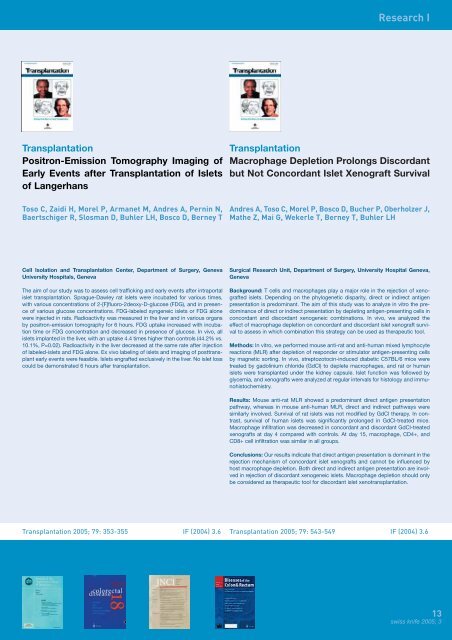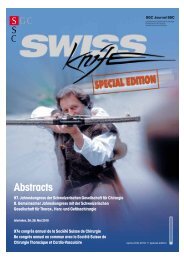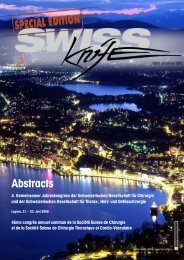Churer Modell - Swiss-knife.org
Churer Modell - Swiss-knife.org
Churer Modell - Swiss-knife.org
Erfolgreiche ePaper selbst erstellen
Machen Sie aus Ihren PDF Publikationen ein blätterbares Flipbook mit unserer einzigartigen Google optimierten e-Paper Software.
Transplantation<br />
Positron-Emission Tomography Imaging of<br />
Early Events after Transplantation of Islets<br />
of Langerhans<br />
Toso C, Zaidi H, Morel P, Armanet M, Andres A, Pernin N,<br />
Baertschiger R, Slosman D, Buhler LH, Bosco D, Berney T<br />
Cell Isolation and Transplantation Center, Department of Surgery, Geneva<br />
University Hospitals, Geneva<br />
The aim of our study was to assess cell trafficking and early events after intraportal<br />
islet transplantation. Sprague-Dawley rat islets were incubated for various times,<br />
with various concentrations of 2-[F]fluoro-2deoxy-D-glucose (FDG), and in presence<br />
of various glucose concentrations. FDG-labeled syngeneic islets or FDG alone<br />
were injected in rats. Radioactivity was measured in the liver and in various <strong>org</strong>ans<br />
by positron-emission tomography for 6 hours. FDG uptake increased with incubation<br />
time or FDG concentration and decreased in presence of glucose. In vivo, all<br />
islets implanted in the liver, with an uptake 4.4 times higher than controls (44.2% vs.<br />
10.1%, P=0.02). Radioactivity in the liver decreased at the same rate after injection<br />
of labeled-islets and FDG alone. Ex vivo labeling of islets and imaging of posttransplant<br />
early events were feasible. Islets engrafted exclusively in the liver. No islet loss<br />
could be demonstrated 6 hours after transplantation.<br />
Research I<br />
Transplantation<br />
Macrophage Depletion Prolongs Discordant<br />
but Not Concordant Islet Xenograft Survival<br />
Andres A, Toso C, Morel P, Bosco D, Bucher P, Oberholzer J,<br />
Mathe Z, Mai G, Wekerle T, Berney T, Buhler LH<br />
Surgical Research Unit, Department of Surgery, University Hospital Geneva,<br />
Geneva<br />
Background: T cells and macrophages play a major role in the rejection of xenografted<br />
islets. Depending on the phylogenetic disparity, direct or indirect antigen<br />
presentation is predominant. The aim of this study was to analyze in vitro the predominance<br />
of direct or indirect presentation by depleting antigen-presenting cells in<br />
concordant and discordant xenogeneic combinations. In vivo, we analyzed the<br />
effect of macrophage depletion on concordant and discordant islet xenograft survival<br />
to assess in which combination this strategy can be used as therapeutic tool.<br />
Methods: In vitro, we performed mouse anti-rat and anti-human mixed lymphocyte<br />
reactions (MLR) after depletion of responder or stimulator antigen-presenting cells<br />
by magnetic sorting. In vivo, streptozotocin-induced diabetic C57BL/6 mice were<br />
treated by gadolinium chloride (GdCl) to deplete macrophages, and rat or human<br />
islets were transplanted under the kidney capsule. Islet function was followed by<br />
glycemia, and xenografts were analyzed at regular intervals for histology and immunohistochemistry.<br />
Results: Mouse anti-rat MLR showed a predominant direct antigen presentation<br />
pathway, whereas in mouse anti-human MLR, direct and indirect pathways were<br />
similarly involved. Survival of rat islets was not modified by GdCl therapy. In contrast,<br />
survival of human islets was significantly prolonged in GdCl-treated mice.<br />
Macrophage infiltration was decreased in concordant and discordant GdCl-treated<br />
xenografts at day 4 compared with controls. At day 15, macrophage, CD4+, and<br />
CD8+ cell infiltration was similar in all groups.<br />
Conclusions: Our results indicate that direct antigen presentation is dominant in the<br />
rejection mechanism of concordant islet xenografts and cannot be influenced by<br />
host macrophage depletion. Both direct and indirect antigen presentation are involved<br />
in rejection of discordant xenogeneic islets. Macrophage depletion should only<br />
be considered as therapeutic tool for discordant islet xenotransplantation.<br />
Transplantation 2005; 79: 353-355 IF (2004) 3.6 Transplantation 2005; 79: 543-549 IF (2004) 3.6<br />
13<br />
swiss <strong>knife</strong> 2005; 3
















